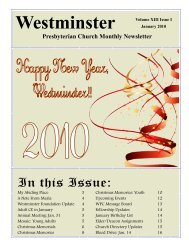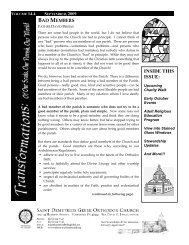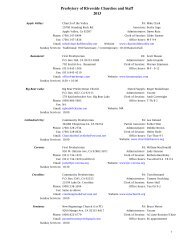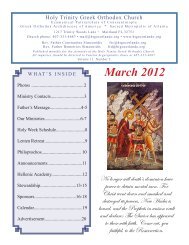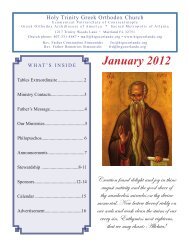OSIS? 2.0.1 User's Manual - Web services are running on AMBIB
OSIS? 2.0.1 User's Manual - Web services are running on AMBIB
OSIS? 2.0.1 User's Manual - Web services are running on AMBIB
You also want an ePaper? Increase the reach of your titles
YUMPU automatically turns print PDFs into web optimized ePapers that Google loves.
• line<br />
Line milest<strong>on</strong>es should be used to mark line breaks in the copy text when they <str<strong>on</strong>g>are</str<strong>on</strong>g><br />
c<strong>on</strong>sidered significant. This will normally <strong>on</strong>ly be true for important manuscripts,<br />
where line numbering may be needed for paleographic or reference use. Line<br />
milest<strong>on</strong>es must not be used to represent linguistically significant line breaks,<br />
such as in poetry, for which the lg and l elements <str<strong>on</strong>g>are</str<strong>on</strong>g> provided.<br />
• halfLine<br />
In certain languages it is important to mark half-line units, and this type is<br />
provided for such cases.<br />
• screen<br />
The milest<strong>on</strong>e of type "screen" is to be used to mark preferred break points in an<br />
<strong>on</strong>-screen rendering of the text. For example, if the user requests to be taken to the<br />
book of Psalms in a given electr<strong>on</strong>ic editi<strong>on</strong>, it may be best not to take them to<br />
Psalm.1.1, but to an earlier point, preceding any introductory material. In many<br />
cases this can be accomplished by taking them to the appropriate div (since the<br />
should precede and Psalms-specific introductory<br />
material); but this milest<strong>on</strong>e type is available for other cases. The <str<strong>on</strong>g>OSIS</str<strong>on</strong>g><br />
specificati<strong>on</strong> does not impose requirements <strong>on</strong> how applicati<strong>on</strong>s make use of such<br />
milest<strong>on</strong>es.<br />
13. Comm<strong>on</strong> elements in all texts<br />
The elements found in this secti<strong>on</strong> can be found in almost any encoded text.<br />
13.1. a<br />
The a element is exactly analogous to the HTML a element, and likewise may be used to<br />
encode links within a document. This eases integrati<strong>on</strong> of <str<strong>on</strong>g>OSIS</str<strong>on</strong>g> documents into the <str<strong>on</strong>g>Web</str<strong>on</strong>g><br />
envir<strong>on</strong>ment. For example:<br />
See Edwards' famous treatise <strong>on</strong> religious<br />
affecti<strong>on</strong>s for additi<strong>on</strong>al informati<strong>on</strong>.<br />
13.2. index<br />
The index element may be placed at any point in the document to indicate a topic under<br />
which that locati<strong>on</strong> should be indexed. It is always an empty element. Multiple indexes



